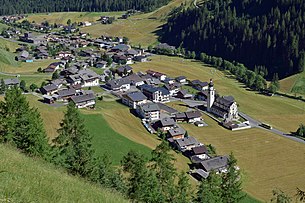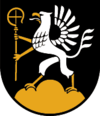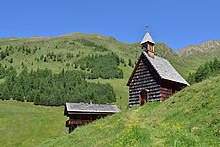Innervillgraten
|
Innervillgraten
|
||
|---|---|---|
| coat of arms | Austria map | |
|
|
||
| Basic data | ||
| Country: | Austria | |
| State : | Tyrol | |
| Political District : | Lienz | |
| License plate : | LZ | |
| Surface: | 87.79 km² | |
| Coordinates : | 46 ° 48 ' N , 12 ° 22' E | |
| Height : | 1402 m above sea level A. | |
| Residents : | 906 (January 1, 2020) | |
| Population density : | 10 inhabitants per km² | |
| Postal code : | 9932 | |
| Area code : | 04843 | |
| Community code : | 7 07 10 | |
| NUTS region | AT333 | |
| Address of the municipal administration: |
No. 78 9932 Innervillgraten |
|
| Website: | ||
| politics | ||
| Mayor : | Josef Lusser | |
|
Municipal Council : (2016) (11 members) |
||
| Location of Innervillgraten in the Lienz district | ||
 Center of Innervillgraten |
||
| Source: Municipal data from Statistics Austria | ||
Innervillgraten is a municipality with 906 inhabitants (as of January 1, 2020) in the Tyrolean district of Lienz in Austria . The community is located in the judicial district of Lienz .
geography
location
Innervillgraten is located in the inner part of the Villgratenbach carrying Villgraten Valley that the Pustertal branches. In addition to the village center, which is concentrated around the parish church, the community consists of widely scattered courtyards ( scattered settlements ) and the Kirchweiler Kalkstein at 1640 m above sea level. The western and southern municipal boundaries are also the border with South Tyrol . Due to its exposed location (breakthrough into the Pustertal), the valley has only been accessible all year round since 1956.
Neighboring communities
The following communities border directly on Innervillgraten: Ausservillgraten , Gsies , Innichen , Sankt Jakob in Defereggen , Sankt Veit in Defereggen , Sillian , Toblach (Italy) .
population
Population structure
In 2012 there were 974 people in the community of Innervillgraten. At the end of 2001, 99.1 percent of the population were Austrian citizens (Tyrol: 90.6 percent); by the beginning of 2012 the value had fallen insignificantly to 98.8 percent. In 2001, 98.9 percent of the population committed to the Roman Catholic Church (Tyrol: 83.4 percent), no person had no religious belief.
The average age of the community population in 2001 was far below the national average. 22.4 percent of the residents of Innervillgraten were younger than 15 years (Tyrol: 18.4 percent), 57.0 percent between 15 and 59 years old (Tyrol: 63.0 percent). The proportion of residents over 59 years of age was 20.6 percent, slightly above the national average of 18.6 percent. As a result, the average age of the population of Innervillgraten rose, especially in the middle population group, but far less than in comparison to other East Tyrolean communities. The proportion of people under the age of 15 rose slightly to 22.8 percent as of January 1, 2012, while the proportion of people between the ages of 15 and 59 increased to 61.0 percent. The proportion of people over 59 years of age fell sharply to 16.2 percent. According to marital status, 58.0 percent of the residents of Innervillgraten in 2001 were single, 37.7 percent married, 4.0 percent widowed and 0.3 percent divorced.
Population development
The population development of the community of Innervillgraten in the late 19th century was below the average population growth of the district of Lienz or the federal state of Tyrol and also developed below average afterwards. Already between 1869 and 1900 Innervillgraten had to accept a decrease in the number of inhabitants of 13 percent, whereby in 1900 with 743 inhabitants a low was recorded for the first time. After that, the number of inhabitants stagnated at first, falling to only 705 people in 1923, the previous absolute low. Thereafter, the population rose continuously until 1981, with the community growing the most between 1923 and 1934. After a decline in population in the 1990s, the population stagnated. Innervillgraten has suffered from a strongly negative migration balance for decades . Whereas in the 1970s this could still be offset by a strongly positive birth balance, a growing negative migration balance and a positive birth balance that more than halved had a strongly negative effect on the population. In the 1990s, the negative balance of migration decreased, while the birth surplus increased again. This enabled the population to be kept practically. Since 2002, the municipality has recorded a negative balance of migration every year, while the birth balance has been mostly positive. However, this was also negative for three out of four years between 2009 and 2012.

Economy and Infrastructure
Workplaces and employees
The workplace census carried out as part of the census in 2001 showed 30 workplaces with 119 employees (excluding agriculture) in Innervillgraten, 79 percent of which were employed. The number of workplaces had risen by two companies (plus 7 percent) compared to 1991, and the number of employees grew by 16 people (plus 16 percent). The most important branch of the economy in 2001 was the production of goods with eight companies and 42 employees (35 percent of those employed in Innervillgraten). This was followed by the hotel and restaurant sector with seven workplaces and 28 employees, and public administration and social security as well as transport with 10 employees each. 40 percent of the people employed in Ausservillgraten were blue-collar workers, 31 percent salaried employees or civil servants and 22 percent business owners.
6.8% of the 484 economically active persons living in Innervillgraten in 2010 were unemployed. Of the 451 employed, 124 were in manufacturing (27 percent), 105 in agriculture and forestry (33 percent) and 41 in construction (9 percent). Other important sectors were trade with 38 employees (8 percent) and the hotel and restaurant sector with 30 employees (7 percent). Of the 443 employed people from Innervillgraten (excluding residents temporarily absent from work), 215 people were employed in Innervillgraten in 2010. 228 had to commute to work. Of the out-commuters, 82 percent had their place of work in the Lienz district, the most important out-commuting communities being Sillian, Heinfels, Lienz and Abfaltersbach. neighboring conurbation Lienz, another 21 percent commuted to Sillian , 17 percent to the neighboring municipality of Heinfels . Another 12 or 4 percent commuted to North Tyrol or another federal state, five of the residents had to commute abroad. In return, only 27 commuters worked in Innervillgraten in 2010, all of whom came from the district.
tourism
Tourism is very important for the municipality of Innervillgraten, especially during the summer season. The tourism intensity (overnight stays per inhabitant) reaches twice as high a value as the district average, in winter the municipality still reaches a tourism intensity that corresponds to the district average. In comparison, however, numerous East Tyrolean municipalities were ahead of Innervillgraten in terms of the number of overnight stays and tourism intensity. Innervillgraten was able to count around 50,000 overnight stays in the 2011/12 tourism year. In the summer half of 2012 Innvillgraten recorded 33,944 overnight stays, in the winter half of 2011/12 16,593 overnight stays. While the municipality achieved slight gains in the summer season compared to the turn of the millennium, it was able to increase the number of overnight stays in the winter season by around 50%. Together with Auservillgraten, the community received the award as a mountaineering village of Villgratental in 2008 and relies in particular on an almost “untouched” natural and cultural landscape, which is characterized by alpine villages and mountain farming crafts. In summer Innervillgraten is a destination for hikers and mountain bikers. In the municipality there are several renters of private rooms and holiday apartments as well as inns and pensions, but no hotel. Numerous alpine huts are rented out in summer as spartan holiday homes - without electricity and sometimes only with cold running water. The community only has a short drag lift and in winter mainly advertises ski tourers and snowshoe hikers, who find a high density of possible tours. There is also a cross-country ski run and two natural toboggan runs in winter. Like all East Tyrolean municipalities, the municipality is marketed by the Osttirol Tourist Association, with Innervillgraten being organized through the "Hochpustertal Holiday Region".
traffic
The municipal area of Innervillgraten is accessible from the Villgratenstrasse (L 273), which branches off the Drautalstrasse (B 100) in Heinfels in the Puster Valley and leads via the neighboring community of Ausservillgraten to the village of Innervillgraten and on to Kalkstein. Innervillgraten is connected to the supraregional public transport network by the Postbus route 8513, which connects Innervillgraten via Panzendorf and Außenervillgraten with the Sillian station on the Drautalbahn .
Sewage association
Innervillgraten belongs to the Upper Puster Valley wastewater association. The wastewater association operates a wastewater treatment plant in Anras, which went into operation in 1990, which cleans the wastewater for eight communities and uses the Drau as a receiving water. The canalization of the community of Innervillgraten was not yet completed in 2002. In 2002, 76% of the 238 objects producing wastewater were connected to the sewer system and the sewage treatment plant. At this point in time, the Heinfels - Innervillgraten association sewer was already in operation and the local sewer system for the Kalkstein district was under construction. The canalization of the Lahnberg district was in the approval process. The waste that arises in the community is disposed of by the Waste Management Association of East Tyrol (AWVO).
Security and Healthcare
The Innervillgraten volunteer fire brigade was founded on December 7, 1901 and was housed in the surrounding feed houses in the village center. Only after the Second World War was the “syringe house” inaugurated in the old inn feed house in 1947. After this house was demolished in 1953, the equipment found a place in the old youth home, from 1956 the equipment was housed in today's schoolhouse. A small fire station was also set up in 1970 in the Kalkstein fraction. It was not until 1991 that the construction of the company's own fire station began. With regard to health care, Innervillgraten is organized in the social district of East Tyrolean Oberland together with the communities of Auservillgraten , Heinfels , Sillian , Strassen , Kartitsch , Obertilliach and Untertilliach . In the health district, for example, health services such as elderly and care help, home and household help, palliative care and family help are organized. The nearest general practitioner is in Sillian, the nearest hospital in Lienz. The nearest police station is also located in Sillian.
Culture and sights
In 2010 caroling in Villgratental was included in the list of Austria (national cultural property) as an intangible world heritage , as declared by UNESCO .
The music group Franui , founded in 1993, comes from Innervillgraten, the name is derived from an alpine meadow in Innervillgraten.
Personalities
- Karl Fürhapter (1802–1883), picture carver
- Josef Schett (* 1960), politician
Web links
- Official homepage of the municipality of Innervillgraten
- Report on the Wegelate saw
- History Tyrol: Innervillgraten
Individual evidence
- ↑ a b c d e Statistics Austria municipality data from Innervillgraten
- ↑ State Statistics Tyrol (VZ 2001) (PDF; 4.1 MB)
- ^ Office of the Tyrolean provincial government, Tyrolean provincial statistics
- ↑ Via the mountaineering village of Villgratental. Austrian Alpine Club, accessed on July 20, 2019 .
- ↑ Ski tours in the mountaineering village of Villgratental. Austrian Alpine Club, accessed on July 20, 2019 .
- ↑ Winter and snowshoe hiking in the Villgratental. Austrian Alpine Club, accessed on July 20, 2019 .
- ↑ The Innervillgraten trail. Austrian Alpine Club, accessed on July 20, 2019 .
- ↑ Tobogganing in the mountaineering village of Villgratental. Austrian Alpine Club, accessed on July 20, 2019 .
- ↑ State of Tyrol, wastewater disposal in the Lienz district (PDF; 7.2 MB)
- ↑ Innervillgraten Voluntary Fire Brigade
- ^ Social district Osttiroler Oberland
- ↑ Sternsingen im Villgratental ( Memento of the original from December 26, 2013 in the Internet Archive ) Info: The archive link was inserted automatically and has not yet been checked. Please check the original and archive link according to the instructions and then remove this notice. . nationalagentur.unesco.at





